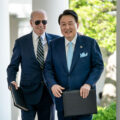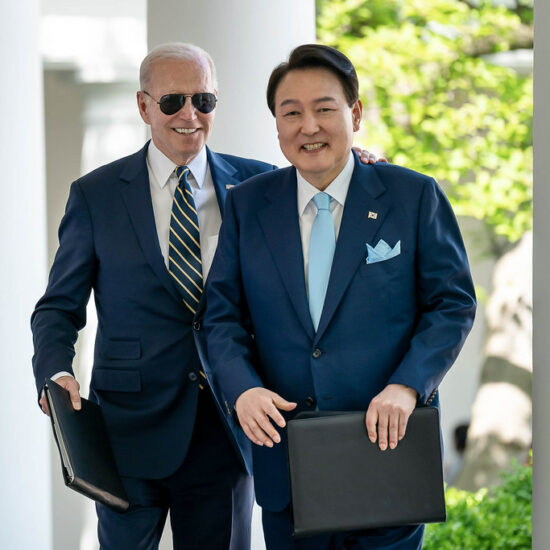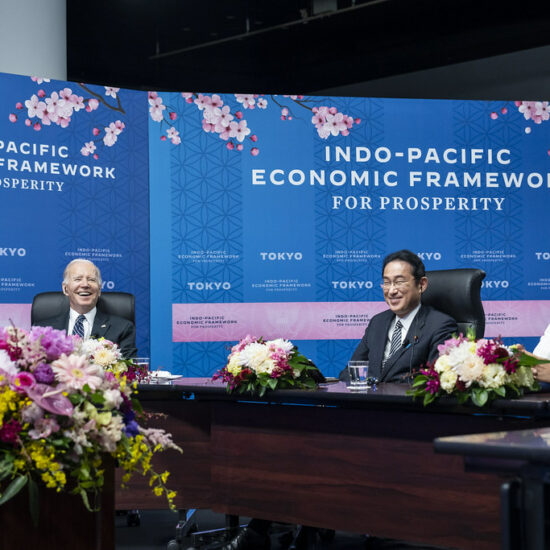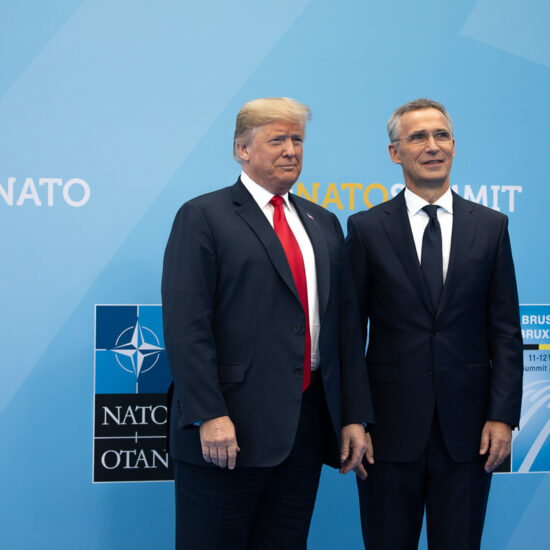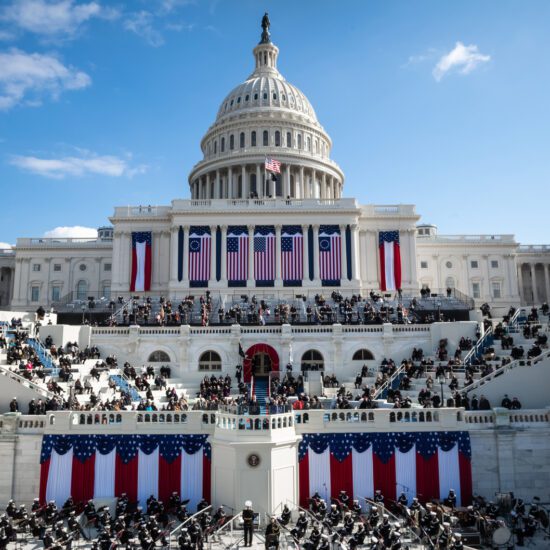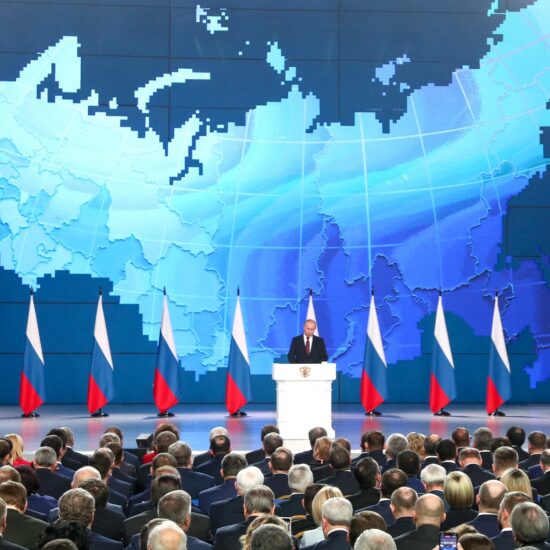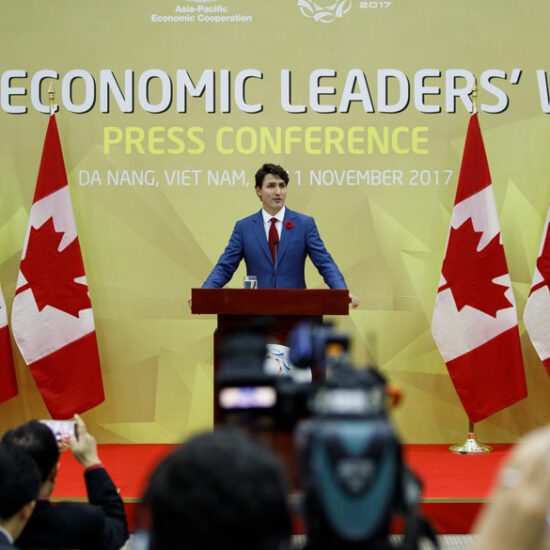
The following are the opening remarks of Evan Feigenbaum, Vice President of Studies at the Carnegie Endowment for International Peace, during a keynote session for the 2022 East Asia Strategy Forum hosted in Ottawa by the Institute of Peace & Diplomacy and the Asia Pacific Foundation of Canada. The dialogue, moderated by APF Canada’s CEO Jeff Nanikvell, featured Feigenbaum’s perspectives on Washington’s foreign policy towards the Indo-Pacific and great power competition.
First, I want to thank the Institute and I want to thank the Foundation. I want to thank Jeff and Jeff. It was easy to have two Jeffs. It’s very good to be back in Ottawa. I haven’t been here since before the pandemic. It’s been for me, as I’m sure it’s been for you, a very strange few years. About four months into the pandemic, my then boss, Bill Burns, called me and he said, “How’re you doing? You’re hold up okay?” And I said, “There are a lot of things I could have done with my life, and I picked international affairs, and I haven’t left my kitchen in about four or five months.” And so, it’s good to be back on the road and to see Canadian colleagues and friends. Thanks for having me.
I’ve been asked to talk to you about the United States and the Indo-Pacific. If you have spent more than two minutes and 27 seconds in Washington, D.C., where I hail from, anytime in the last few years, you will know that that story, generally speaking, begins with security balancing of China. The middle of the story is security balancing of China. And then the end of the story is security balancing of China. If you all want to talk about security balancing of China, I am very happy to do that in the conversational part of this. But if, by contrast, you’ve spent more than two minutes and 27 seconds out in the region rather than just in Washington, D.C., you will, of course, know that this part of the world is not just complex, which is a bit of a cliché, but it is multifaceted, it is multidimensional, and in a lot of areas that matter to governments and firms and market participants and people, it is increasingly multipolar.
And so, that’s what I thought I would use the setup to talk about how the United States in the Indo-Pacific is or is not navigating what I would call three collisions that I think reflect the region that actually exists rather than the ones of American wishes, dreams, and fantasies. The first of those is the collision between economics and security. The second is the collision between coalition building and some of the realities of fragmentation, not least among democracies in this part of the world on issues and functions that matter, as I said, greatly. And then third, the collision between America’s approach to strategic competition with China and, with a few exceptions, what I would characterize as pretty much everyone else’s approach to the same. You asked me to talk for about 15, 20 minutes. I’ll take about five minutes on each of those three, and I’ll try and provoke you a little bit.
And then if you want, we can just ignore it all and go back to security balancing of China and talk about Taiwan. Okay? All right. On the first, to my mind, the central strategic dynamic in this part of the world, other than the obvious one, which is the increasingly confrontational relationship between the U.S. and China, is what I would call the collision between economics and security. Or to put that another way, between economic integration and security fragmentation. 10 years ago, I wrote an article in Foreign Policy magazine with a colleague of mine, a guy named Bob Manning, called “A Tale of Two Asias.” And essentially what we did was we told a kind of Jekyll and Hyde story about this part of the world, and how it had evolved over the previous couple of decades. On the one hand, you had… we called it economic Asia.
This is a region with, however you count who’s in or out, $25, $30 trillion regional economy, countries that are growing together, trading together, investing together, building together in many areas. They’re innovating together. And they’re building an Indo-Pacific with East Asia as the anchor that is really, in many ways, the most economically successful part of the world over the last several decades. But then, and now I can tell you the story of the same region in a completely different way, security Asia. The same countries that are trading, building, investing, growing, and innovating together are, in many cases, beset by powerful nationalisms. They have territorial disputes, they’re building blue water navies, they’re arming for conflict. And pathologies that a lot of people thought were frozen in time have essentially roared back front and center with a vengeance. And so, in that dynamic and the push and pull between those, there’s the question of how major countries that have both economic and security interests navigate that duality.
Now, from the 1990s until, I’d say 2010-ish, I would’ve told you that economic Asia was decidedly winning this contest. The reason for that was really twofold; one is the Asian financial crisis. When a lot of governments and frankly a lot of people looked at each other and said, “What the hell is security if your economy can just be blown up in an afternoon?” Maybe security and conceptions of security need to be broader than just military security. But then second, American policy had something to do with this. And in fact, bad American policy had something to do with this, and particularly to the turn by many Asian countries to one another to navigate some of these challenges. You remember, the United States bailed out Mexico in 1994, then refused to bail out Thailand three years later and paid a price. I would argue among many Southeast Asians for that.
That’s been the dynamic. But from 2010 on, a lot of security issues really roared back front and center. You heard a little bit about it from Ariana. I understand it was front and center in a lot of your discussion yesterday. We hear about it, as I said, in Washington, D.C., and in Beijing, China on a daily basis. And so, this security fragmentation threatens to overwhelm a lot of the economic integration that had been so important to people, firms, markets, governments, and the future of that part of the world. Now, that’s a challenge for the United States, despite all the talk about security balancing, because the region has evolved a lot in the face of that push and pull. If I think about American leadership in this part of the world, particularly in the period after the Cold War, the United States was a leader because it was the principal provider in the first instance of security-related public goods through its alliances, its forward deployed military presence, carrier battle groups.
It was the security provider either directly for its security allies or indirectly for those countries who basically were taken a free ride off the security of public goods that the U.S. presence provides, except for who? China, which, in a lot of ways, objects to elements of that presence. When I project out over the next five or 10 years, there’s really no challenge to that American role. Because until China and Japan have a moment that is analogous to the one that France and Germany have had in Europe, there’s no basis for collective security in the Pacific. And if there’s no basis for collective security in the Pacific, then the United States was, is, and as far as my eyes can see, going to continue to be an important, and in many cases, principle provider of security for nearly everybody, but who? China. And so, the security questions involve investing in alliances and partnerships, modernizing platforms, ensuring access.
These are operational issues. They’re not fundamental existential strategic issues because there’s no basis for collective security. But that security role, as Kevin, Alice, and others know, that was not the whole story of the American role in the region. The United States was also a leader because it was the principal source of demand for a lot of Asia’s export-led economies to power their way to prosperity, and it was a leader on standard setting and across and behind the border liberalization as that became a major issue on the agenda. So, there’s no basis for collective security, and the United States will continue to be a major security provider. But if I look down the road, I see the U.S. demand profile in many areas shrinking, not in absolute terms, but in relative terms, U.S. trade with every country in Asia has gone up in absolute terms. It’s declining almost everywhere in relative terms.
And if your role as a demand driver is shrinking, then you need to fall back for economic leadership on what? On that other pillar to be a standard-setting nation. The last panel talked a little bit about some of the trade agreements and packs that are setting standards in this part of the world. So, there are three, for example, that people tend to focus on: the regional comprehensive economic partnership; the comprehensive and progressive transpacific partnership; the digital economy partnership agreement. Three agreements that will help to set standards for the next generation in this region. Guess who’s not in any of those three? The United States is on the outside looking in. And guess who else is not in any of those three? India. So, the United States premises its strategy for this part of the world on, as I said in the setup, the Indo-Pacific. But in this area, the largest economy in the Indo, and the largest economy across the Pacific are both missing in action.
And if you ain’t got no Indo and you ain’t got no Pacific, you’re back to the centrality of Asia. And that is not a region or a set of challenges that American strategy or policy has figured out how to navigate. Now, the good news is that there are a lot of issues and functions that are beyond the scope of those agreements or other existing patterns of agreement between powers and players in this part of the world. Digital trade’s a good example. There’s a lot of bad cross-border data that is in play.
But the bad news, and this comes to my second point, is that a lot of the countries that the United States wants to lean most heavily on to counterbalance Chinese power actually are not on the same page as American policy in a lot of those areas. Data governance is a good example. Okay? In 2019, Prime Minister Abe of Japan was in the chair of the G20, and he had something called the Osaka Track, the Osaka Initiative on Data Governance, which he called free flow of data with trust. And guess who refused to sign up to it? India in the first instance, Indonesia in the second instance. Two successful consolidated Asian democracies, one of which is a member of the Quad. The United States is banking heavily on India to counterbalance the rise of Chinese power. Indonesia, a country the United States would like to bank on heavily to counterbalance the rise of Chinese power. So, on a lot of these issues, not just data governance, but issues in functions that touch the interstices between economics and security, economics and technology, open data, cross-border data, online authentication, and data access control. There is no one set of rules, standards, or prevailing norms.
And in many major economies, the ones that prevail are not necessarily the ones that are to American liking. India’s the best example of this. I mean, look at the debates in India, for example, on data localization, where both the law enforcement authority and, frankly, the privacy regulator have an approach to localization that requires most data to be stored locally. And that’s a function of the Indian system, privacy regulators, law enforcement, they don’t want Indian citizens’ data stored in servers offshore.
They want to be able to access that. The point is the region is developing because of that; different models, and rules, and standards, and is heading, in many areas, for something that I would characterize more as fragmentation than as integration. Why do I say the United States needs to struggle with that collision? Because it’s beyond the scope of the way a lot of American strategists talk about this part of the world, where the only possibilities are Chinese unipolarity, American unipolarity, or some sort of Cold War-like bipolarity, where the United States and China will be the poles, and everybody will line up on one side or the other.
If you want to see that kind of thinking in action, let’s just look at an interview that President Obama gave in, I think, 2016 with Gerry Seib of the Wall Street Journal. President Obama was trying to make the case for the TPP. Remember when the U.S. was interested in the TPP? It’s back in the Jurassic era. He argued it this way, partly for political effect domestically, but I think it’s instructive. He was asked, “Why should the United States join the TPP?” And the president said, “Well, because if we don’t write the rules, China’s going to write the rules out in that part of the world.” But if President Obama had been right about that, then when President Trump withdrew the United States from TPP, what should have happened? Logically, China should have come in and become the rule rider.
But as we all know, that’s not actually what happened. What happened, the other 11 got together, solidified the agreement, albeit influenced by the United States, and the text the United States wanted, but with neither the United States nor China in a room. So, clearly there’s something going on in a region that belies these very straightforward notions of bipolarity or unipolarity. I think, in a lot of ways, the region is heading for what I would call fragmentation on things that are meaningful for the interest of the United States. And that’s the second collision that the United States has not really figured out how to navigate through a prism that’s focused almost exclusively on balancing Chinese power.
So, that brings me to the third point, which is American policy toward China. I don’t know how much you’ve noticed the change in Washington over the last several years. But I’ve worked on U.S.-China relations for 25 years, and I will tell you there has been a sea change in the last seven or eight years in the thinking about China in that capital city, and frankly in the American body politic, more broadly, and it’s really got a bipartisan basis. The way it’s sometimes characterized is that the U.S. is very focused on strategic competition with China. That’s not quite it. When Richard Nixon went to China in February, 1972, which is the modern inception of the relationship, the United States and China were fighting a proxy war in Vietnam, and China was just crawling out of a cultural revolution. So, from the very inception, there were clashing security concepts, and there were obvious differences of political system and ideology baked into this relationship.
But after the U.S. and China developed an economic relationship, and particularly after China came into World Trade Organization in 2001, these large-scale flows of five things; goods, capital, people, technology, and increasingly of data, happened, I would argue, largely on a parallel track. People in the markets, people in corporate C-suites, they’re not morons. They weren’t unaware of these security issues around Taiwan, the South China Sea. But the point was they didn’t impinge on most business models for China, and they rarely impinged on a trade if you were trading stuff in the markets.
So, what’s changed in the last several years is not that strategic competition is somehow brand new, and it’s a revelation, it’s that economics and security have largely collapsed together. And what’s more, and this goes to a point that Paul Evans made in a question to the last panel, not only have economics and security collapsed together, but those economic flows that I talked about, capital people, technology, data, increasingly are being refracted on both sides, but particularly on the American side through the prism of national security. And that’s what a lot of us like to talk about when we talk about securitization.
So, if everything is security, then those things will not be separable. What’s happened, particularly in the last two administrations, one Republican, one Democrat, is that the American strategic class, of which I’m a card-carrying member, the American political class on a bipartisan basis, and if I may say so, the American regulatory class has discovered that there were a lot of regulatory and administrative instruments that were sitting out there that could be leveraged and deployed in interesting, expansive, and sometimes extremely creative ways. Take a sector like artificial intelligence, I would have trouble naming for you a Chinese AI player that hasn’t landed on the Commerce Department entity list. There’s other instruments, use of the Foreign Direct Product Rule. You’ve read about these semiconductor controls that have just come out, other export controls. New and expansive notions of what constitutes national security and CFIUS.
I worked eight years for Hank Paulson. He’d been the chairman of Goldman Sachs. He had a pretty narrow definition of what constituted national security. It’s very expansive today. There’s a so-called Military Company List administered by the Department of Defense. Doesn’t have enforcement teeth, but if you land on that list, you are toxic as a Chinese company. Nobody’s going to do business with those companies. So, there’s this use of administrative and regulatory instruments in the context of securitization that I think if you pull the thread and you project out four or five years is going to define a lot of elements of American financial policy, investment policy, commercial policy.
And people in the markets are well aware of what that means for their business and the ways in which it restricts things that were easier to do five, six, seven, eight years ago. Now, why is that a collision? It’s a collision because if that’s the trajectory of American policy, it begs the question of whether it’s the trajectory of everybody else’s policy. I will tell you, the United States is increasingly extra-territorializing the application of these instruments precisely because it is not the trajectory of everybody else’s policy. If it was, ideally, what the United States would want to see is other countries deploying export controls and administrative and regulatory instruments in an identical way vis-à-vis China as a trading partner, as a capital partner, in or out, and particularly in the technology and data space.
Because that’s not happening, the United States is attempting to elicit voluntary compliance. And if it cannot, I confidently predict to you the United States is going to bring the hammer down. Going to bring the hammer down and try to coerce compliance on a lot of these controls. And it reflects this American zeitgeist on competition with China, which, by the way, is mirrored, in some respects, on a Chinese side. And the Chinese have built their own architecture to use administrative and regulatory instruments and are trying to offshore it in the same way. But it will catch other countries not called the United States and China betwixt and between. And so, that really circles me back to where I start. That’s a collision for the United States, because if American policies and strategies for strategic competition with China are not mirrored elsewhere, we’re heading for a somewhat fractious period between the United States and the very partners that it needs to navigate competition with China.
So, you often hear this talking point from Washington, the United States isn’t forcing countries to choose. We don’t want anybody to have to choose. Okay. Try putting a Huawei kit in your 5G backbone and see how the United States feels about you not making a choice. Try not complying with U.S. export controls and see whether the United States wants you to make a choice. Try making Huawei your cybersecurity partner of choice as Indonesia has. I just published a paper on this at the Carnegie Endowment. All those political tensions between China and Indonesia, guess who’s doing cybersecurity backbone solutions in Indonesia? Huawei. How does the United States feel about that? Would you prefer that you don’t make a choice?
Those contradictions are going to get sharper and sharper. And so, my very direct answer to Paul’s very direct question is that’s the trend line and trajectory. Now, the conventional Washington story is everybody needs to adjust to that because the U.S. is weighty, and big, and has power, and has scale. But what I’m trying to tell you is that quite apart from the debate about security balancing in the region that exists rather than the one of American wishes, dreams, and think tank fantasies, and I say that as the vice president of a major Washington think tank, the United States is going to figure out how to have to navigate that as well.
That’s really somewhat beyond the scope of the strategic conversation in the United States. And it’s where, if I may be blunt about it, when the United States has no better partners, Canada’s one of them, the best partners are the ones that need to speak with intellectual honesty, but also find ways to help the United States navigate that set of contradictions too. If everything was just security balancing of China, the world would be so much simpler and so much easier. But the world, as I said, it’s not simple, and it’s complex and it’s multifaceted. That’s what I wanted to say to you by way of opening because it’s not something that I think the United States has fully come to appreciate. And so, it’s probably not something you hear often from Americans. Why don’t I stop there, and if you want to just ditch it all and talk about the South China Sea, let’s talk about rocks.

